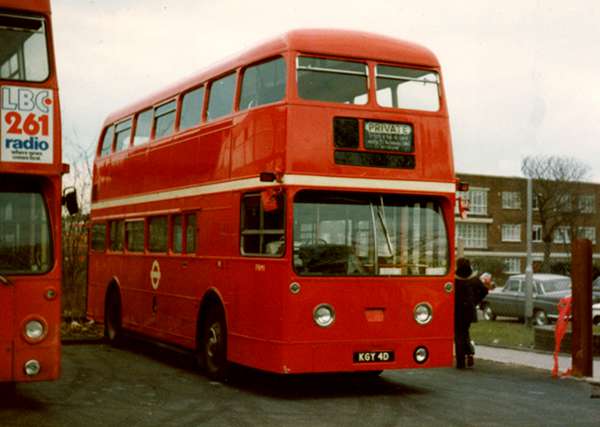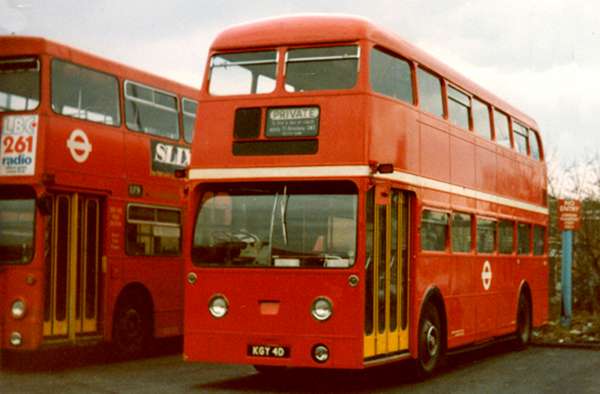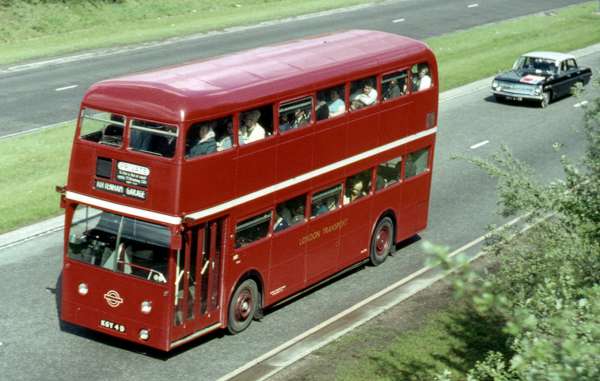The One and Only FRM 1
The One and Only FRM 1


A week or so ago I received quite a few photographs that were the collection of Eddie Collings, they were donated to the Old Bus Photos website by Margaret, Eddies daughter. I was very pleased to find the above shots and Eddie must of known the importance of this vehicle because he took two cameras with him that day to make sure he got shots of FRM 1 the one and only rear engined Routemaster.
Peter
18/04/13 - 07:31
This is the bus that Alan Townsin said set the standard for all others to follow. So Leyland killed it. It conflicted with their Atlantean, which they were promoting vigorously, and London Transport gave up on it because it didn't fit in with their restructuring plan -the politicians thought they were spending too much money on the development. [Bit of a common theme? Leyland and politicians?] There should have been three FRMs at the motor show (including one in Sheffield colours) but the other two weren't even built. Northern General and Yorkshire Traction were rumoured to be interested - "off the drawing board". It took until 1972 for the (AN68) Atlantean to be any good and, to be fair, the TN Titan turned out to be the '70s version of what the FRM should have been. Don't you just love our politicians and British Leyland? What do you mean? Me? A bitter, twisted old man?
David Oldfield
18/04/13 - 08:18
Whilst FRM1 was in many ways an excellent vehicle and an advance, certainly in engine and power train maintenance terms over the competition then on offer, one wonders just how many operators would have embraced the design and method of construction.
Given the minimal take up of the standard Routemaster and the 1970s Titan outside of London, one can only think that it would have followed a similar path.
Phil Blinkhorn
18/04/13 - 08:59
Regrettably, Phil, you are probably right. There has always been a resistance, until quite recently, to integral vehicles. Leyland had to (quickly?) rethink on a number of occasions. Olympic/Royal Tiger; original Olympian/Tiger Cub; show model (integral) Atlantean/production PDR1/1; TN Titan/ON Olympian. Leyland tilted at windmills (no AEC pun intended) for about three decades only to be overtaken by the recent trend - started in coaching - for marketing packages (cf Scania/Irizar) which removed choice of chassis and bodywork from the customer. This is exacerbated by the lack of choice in the current market - oh dear another case of British Leylandism revisited.
David Oldfield
18/04/13 - 11:40
It always surprised me that the London Transports Tram & Trolleybus Division (dominated by ex-LCC tram management, who might have been otherwise regarded as yesterday's men) embraced integral trolleybus bodywork from about 1936, with most designs being successful and long-lived. In fact, most of their trolleybus body problems revolved around half-width front bulkheads to squeeze a couple more seats in facing the driver side-on.
I suppose that such construction might have been used on bus chassis had the RT not been in development.
Strange, though, that left-hand and right-hand went such different ways.
Chris Hebbron
18/04/13 - 16:43
I'm afraid its true that Leyland found out the hard way and paid the price for telling the customer what they WILL have. Two of the final nails in the coffin must have been the awful goods based "Cub" and - I must moderate my words here for public decency - the indescribable Lynx.
Conversely Dennis succeeded, and rightly deserved to, by obliging the customer with a wide range of vehicles to suit every need.
Chris Youhill
18/04/13 - 16:44
Left hand and right hand? Sounds like the inspiration for the Twix ad!! The probable reason for the RT being designed as a chassis/body combination was the perceived need to replace a large and diverse range of vehicles in short order, something that pre-war would have caused problems for a single provider. As the war intervened and there was a massive demand for new vehicles post 1945 this proved to be an inspired decision.
By the time the RM came along they were still hedging their bets with prototypes being built by Weymann and ECW. When bulk orders were ready to be placed the demand for vehicles had slackened and PRV were able to cope, possibly to its disadvantage when competing for other work.
Phil Blinkhorn
18/04/13 - 16:46

Here is a picture of FRM 1 on a Brighton HCVC run, at a time when it was still in LT service at Tottenham Garage. It was later allocated to Croydon Garage where I personally rode on it quite frequently on the hilly 234 route between Purley and Selsdon. It was an impressive performer. One aspect of the design of this vehicle was overtaken by London Transports change in specification to dual doorway layout. It has been suggested in some quarters that the integral structure of the FRM did not lend itself to a hole being made halfway along the nearside to allow the installation of a second doorway. In any event, Stokes was adamantly against it, so that irrespective of merit, oblivion was inevitable.
Roger Cox
18/04/13 - 16:49
The arguments for and against have been long debated. The one thing that we don't know is whether the vehicle in series production would have suffered similar problems to the other rear-engined products of the same era. It was a time where undertakings of all sizes were affected by the down-turn in traffic as people bought affordable private transport, opportunities for better-paid, non-shift-work employment was affecting the quality of recruitable staff on both the operations and engineering side. Not the best time for new technology to be entering the market.
Anyway . . .
One of the fascinations of FRM 1 is that it is a genuine one-off. Can anyone bring to mind anything else from the post-war period that fits this description? I would put forward the super-short Fleetline at Walsall, 1 UDH for starters.
Alan Murray-Rust
18/04/13 - 17:37
Yes, Alan, even Rowe and Rutland managed about three chassis - but these were an entire run for a manufacturer.
Phil. Nothing has ever been properly analysed but your comment about PRV's inability to cope with demand is very pertinent. Ever since the ACV take-over, a year after they had taken over Charles H Roe, it was decided first to subcontract all "composite" orders to Leeds but subsequently large orders of PRV designed metal-frame orders were sent to Leeds. All the early Atlanteans were subcontracted, but there were also the Tracky PS1 and PS2 rebuilds - almost pure PRV. All of these were at the height of Routemaster production - and I don't think that that was a co-incidence. Roe built the three AEC Renowns for Rotherham, but superficially they were standard PRV. Another interesting aside is that PRV picked up the last SELNEC order for Mancunians from East Lancs but they in turn couldn't cope and further subcontracted to Roe in Leeds ("which did it's usual high quality job" Eyre & Heaps - Manchester & Salford "Glory Days"). Roe had never done Mancunians before.
David Oldfield
18/04/13 - 17:43
The SHMD Atkinson double decker springs to mind as a one off.
Phil Blinkhorn
19/04/13 - 06:37
Another one off from the AEC stable would be the Regent 4. Pretty close would be the two Lowloaders from Leyland and the two D10's from. BMMO. Would the Walsall long Fleetline count?
Andrew Charles
19/04/13 - 06:38
Oh, how I agree with Chris Youhill about the Leyland Lynx. I only ever drove examples of the Cummins engined version, powered by the savage "on/off" L10, but I nominate it as the most unpleasant bus I have ever had the misfortune to handle. It was equalled in nastiness only by the utterly primitive, impossibly noisy, crudely sprung Seddon Pennine IV, which needed almost constant correction to keep in a straight line. I never liked the driving the type on short, local bus services, but I once took a Pennine IV from Gomshall, Surrey, to Yeates at Loughborough, where it was exchanged for a Bedford YRQ. I had often driven YRQs and other Bedfords before, but I confess to having had something of a patronising attitude towards post OB Bedfords. The contrast between that Pennine and the Bedford was extraordinary - the YRQ was a Rolls Royce by comparison - and it taught me a new respect for a lightweight vehicle manufacturer that actually knew its business.
Phil, you are right about the solitary Atkinson PD746, though two chassis were actually completed and exhibited at the 1954 Commercial Motor Show. The second never received a body, and was later dismantled.
Roger Cox
19/04/13 - 07:17
How about as another 'One Off' the Dennis Pelican.
Trevor Knowles
You can read about the Pelican on Ray Sopers Chiltern Queens of Woodcote gallery.
19/04/13 - 09:03
And only two Dennis Dominants. A third was displayed in chassis form only at the 1950 Commercial Motor Show, but later dismantled.
Roger Cox
19/04/13 - 10:57
More one-off’s would be London Transports six-wheel double-deck Q188 and 1671, its twin-steering Leyland trolleybus. And I suppose all three Gilford double-deckers, all of different design.
As for FRM!, it might have appeared in 1966, but by 1968, LT was under the political control of the GLC under Red Ken Livingston, with his Fares Fair policy and not bothering with a profit any more. This must surely have also influenced the decision to go for cheapness rather than quality.
Chris Hebbron
19/04/13 - 12:06
Another one off by AEC the solitary AEC Sabre coach with ECW bodywork. There was also the Foden/Northern Counties decker total production 6 and the solitary IVECO decker.
Chris Hough
19/04/13 - 12:08
Chris H: I was specifically interested in the postwar era for one-offs, as the earlier period is undoubtedly full of them, many relatively undocumented.
Thanks to others for the Pelican and the Atkinson, both of which had slipped my mind. Walsall's 36ft Fleetline must also qualify if the short one does - remarkable that the same undertaking felt the 'need' for both!
I also have in mind body-builder one-offs, such as the only double-decker by Fowler (for Fishwick).
(I can think of a number of other pairs to match Roger's Dominants, but true singles are rare)
Alan Murray-Rust
19/04/13 - 17:12
Alan all of my other examples date from the seventies and eighties. One saloon from that ere was the ACE Cougar only two of these were ever built one going to Peoples Provincial of Gosport the other being a demonstrator.
Chris Hough
21/04/13 - 07:56
Chris
Although the GLC was formed in 1964/65 it didn't assume control of London Transport until 1970 (when the London Transport Executive replaced the London Transport Board), and Ken Livinstone wasn't "elected"/imposed [sic] as Leader until 1981 - the "Fares Fare" policy didn't come in until after his ascendancy. Was the London Transport Board required to return a profit on its "stock": that's an interesting point!, but I'm not sure how much "profit" actually translates into investment in vehicle design - BET was undoubtedly profit-driven but was behind/involved in some of most cost-conscious innovations of the 1950s (single-skin roof domes, single rear wheels, use of glass-fibre, Albion Aberdinian) . . . errm . . .OK . . . "profit" may have an input into vehicle design (though perhaps not a wholly positive influence!).
Philip Rushworth
Comments regarding the above are more than welcome please get in touch via the 'Contact Page' or by email at obp-admin@nwframpton.com
All rights to the design and layout of this website are reserved
Old Bus Photos from Saturday 25th April 2009 to Wednesday 3rd January 2024